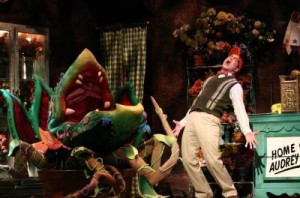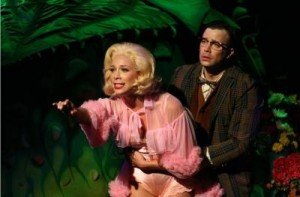
For a 1982 off-Broadway musical based on a no-budget black-and-white film shot in two days, Little Shop Of Horrors has come a long, long way. A London West End production opened in 1983 and a movie version was released in 1986 even as Little Shop continued to entertain off-Broadway audiences for an amazing 2,209 performances. A big stage revival finally took the show to Broadway in 2003. Few are the high schools, community theaters, and regional CLOs which haven’t staged Little Shop at least once in the past twenty-seven years. Little Shop Of Horrors is that rarity in musical theater—a show which works equally well in a tiny space and on a Broadway-sized stage, one which can delight and entertain whether performed by teenagers, amateurs, or the kind of A-List professionals now starring in Musical Theater West’s sensational big theater revival.
Broadway leading man Danny Gurwin is Seymour Krelborn, a 30something orphan (and nerd extraordinaire) who works in the crummiest and least successful flower shop on New York’s skid row. In fact, business is so pitiful at Mushnik’s Skid Row Florists that cranky middle-aged owner Mr. Mushnik (Stewart Pankin) has informed his two (and only) employees, Seymour and bleach blonde bimbo-with-a-heart-of-gold Audrey (Lowe Taylor), that the time has come to close shop for good. Fortunately for Seymour and Audrey, a customer (the first they’ve had in days) is so charmed and fascinated by the “strange and interesting plant” sitting in the store window that he buys $100 worth of roses. This starts Mushnik and Seymour to thinking—could this plant, which Seymour just happened to find not long after a total eclipse of the sun, be the answer to their prayers?
Before long, business is booming, Mushnik is thinking of adopting Seymour, Seymour is finding it harder and harder to think of the va-va-voomy Audrey as just a co-worker, and Audrey is wondering if maybe Seymour might just be the knight in nerdy armor who can rescue her from Orin Scrivello D.D.S. (Peter Paige), her sadistic dentist boyfriend. Meanwhile, a trio of grade school dropouts named Chiffon, Crystal, and Ronnette (60s girl group fans will understand at once where their names come from) keep popping up to comment on the action and to sing backup to songs by Howard Ashman and Alan Menken.
There’s only one problem with the strange and interesting plant, which Seymour has named Audrey II in honor of his dream girl. Said plant, which starts out a cute little green thing, possibly of the Venus Fly Trap family, has a craving for blood, human blood, and the drops Seymour gives it from his increasingly bandaged fingers are soon nowhere near enough to satisfy its cravings. Audrey II wants a body’s worth of blood, and it wants Seymour to supply it posthaste.
For the few who’ve never seen Little Shop Of Horrors (there must be some of you out there), plot synopsizing ends here so as not to spoil Little Shop’s many surprises. What remains is simply to list the many reasons why MTW’s Little Shop Of Horrors proves a perfect big stage revival, one that is sure to delight and charm audiences throughout its run.
Much of the credit goes to director Steven Glaudini, who has wisely followed Ashman’s Author’s Note that “the script keeps its tongue firmly in cheek, so actors should not.” Considering the caliber of Glaudini’s cast, it’s no wonder the singing is great, but the very real performances owe much to Glaudini’s expert guidance.
It’s great fun to watch Gurwin playing against type as Seymour. Casting the Broadway heartthrob (he was Sutton Foster’s Laurie in Little Women) as a nerd is a bit akin to Nicole Kidman’s playing Virginia Woolf in The Hours (though without the prosthetic nose), but like Miss Kidman, Gurwin knocks the role out of the ballpark. No matter how outrageous the situation, Gurwin is never anything less than real, and that makes his Seymour all the more lovable and his relationship with Audrey all the more poignant. That Gurwin is one of the best singers around is icing on the cake.
As Audrey, Lowe Taylor gets the big stage in-the-spotlight starring role that this charismatic emerging musical theater star so richly deserves. Never overplaying, Taylor makes Audrey’s self-destructive relationship with her monster of a boyfriend absolutely real, and her feelings for her nebbish of a coworker absolutely believable. Audrey may be a dumb blonde, but she’s got street smarts, and a heart full of love to give to the right man. Taylor gets to sing the show’s two best songs, “Somewhere That’s Green,” and (duetting with Gurwin) “Suddenly Seymour” and she stops the show both times.
Pankin couldn’t be better as Mr. Mushnik, and like Gurwin and Taylor, he avoids caricature, making this a darker than usual Mushnik. It’s a darkness which works, as Seymour’s adoptive father’s amateur sleuthing leads him straight to his son’s doorstep. (He’s also very funny in the role.)
Melony Collins, Kamila Marshall, and Fredericka Meek are dynamic singers and deft comediennes as Little Shop’s answer to Dreamgirls, sassy, sexy, and supreme at singing and/or backing up the title song, “Skid Row,” “Da-Doo,” “Dentist,” “Suddenly Seymour,” and “The Meek Shall Inherit.”
The one actor who is (quite correctly) allowed to chew the scenery is Paige, whose presence in the show is sure to bring out Queer As Folk fans eager to see their Emmet on stage. Paige steals scenes right and left as not only Orin, but the customer who starts the ball in motion, and (in a series of lickety-split costume changes) fast-talking NBC exec Mr. Bernstein, elegant Life Magazine editor’s wife Mrs. Luce, and super agent Skip Snip. Who knew that flamboyant Emmet was such a versatile and talented musical theater star? Hopefully, we’ll get to see much more of Paige on our CLO stages in months to come.
Michael A. Shepperd and James W. Gruessing appear briefly as skid row bums in the first scene, then vanish backstage where Shepperd voices Audrey II in 60s soul artist tradition and Gruessing takes charge of Audrey II “manipulation.” Kudos to both.
Menken’s tunes are as lovely and catchy as those he later wrote for The Little Mermaid, Beauty And The Beast, Aladdin, etc. Ashman’s hilarious book, which sends up those 50s horror flicks inspired by Cold War paranoia, and his clever lyrics make his 1991 death from AIDS all the more tragic a loss. He’d only be 59 today had he lived.
Everything about MTW’s production is top-of-the-line. DJ Gray’s choreography combines 50s/60s girl group moves and a smidgen of Fiddler On The Roof. Daniel Thomas’ musical direction is terrific as always.
You won’t find a better-looking CLO production than this one, and if it looks Broadway caliber, it is. Sets are the original Broadway/tour scenic design by Scott Pask and they’re at once gorgeous and kooky. The same can be said for William Ivey Long’s original Broadway costumes, coordinated here by Yolanda Rowell. Jean-Yves Tessier lights the sets and costumes to perfection. Julie Ferrin’s sound design is never anything less than excellent.
Even if you’ve seen your kid’s or sibling’s high school musical production of Little Shop, or one of the numerous local 99-seat revivals, or the Broadway tour which played the Ahmanson, do yourself the favor of checking out Little Shop Of Horrors at its biggest, its most professional, and its best in this all-around sensational MTW production.
Musical Theatre West, Richard and Karen Carpenter Performing Arts Center, 6200 Atherton Street, Long Beach.
www.musical.org
–Steven Stanley
July 16, 2009
Photos: Ambrose Martin




 Since 2007, Steven Stanley's StageSceneLA.com has spotlighted the best in Southern California theater via reviews, interviews, and its annual StageSceneLA Scenies.
Since 2007, Steven Stanley's StageSceneLA.com has spotlighted the best in Southern California theater via reviews, interviews, and its annual StageSceneLA Scenies.







 COPYRIGHT 2024 STEVEN STANLEY :: DESIGN BY
COPYRIGHT 2024 STEVEN STANLEY :: DESIGN BY